HMS Whimbrel
The Last of the Black Swans
Update: 29 October 2021
October 29th 2021: Distinct probability of Whimbrel coming home. Eqypt is retiring the ship and 'in favour' of returning her.
http://petitions.number10.gov.uk/HMSWhimbrel/
MARCH 2014: English Heritage Lottery are willing to help any organisation that wants to bring Whimbrel home.
If
your organisation is thinking of applying, please read the application guidance,
in particular the ‘outcomes’ for the programme.
I must point out that I am nothing at all to do with the Whimbrel negotiations or any official body involved in her proposed return, I do this purely as a hobby and people kindly keep me informed.
|
Up to March 2021 the fate of Whimbrel is unknown Oct 29th. News Tariq is being retired we can maybe have Whimbrel back I have received 63 images of a sailor who served on Whimbrel and before that the destroyer I.48, Vidette. They are here, many of which are unknown Richard Park served firstly on Vidette from early 41 to Jan 1942 and then on Whimbrel Jan 43 to September 45. He died in 1986.His nephew, Kris Morton sent me these pics. |
Rods
details are updated as follows: Please note I am also the archivist for the WHIMBREL project and would appreciate any photographs or information about the ship and her history for inclusion in a book that I am writing. Rod Pudduck OBE CEng FRINA RCNC HMS Whimbrel (1942-1949) Battle of the Atlantic Memorial Trust Jones
House rodkp - at - btinternet.com - change the -at- for @ to email him. |
| HMS WHIMBREL (1942-1949) BATTLE OF THE ATLANTIC MEMORIAL | |
|
The Project led by
Vice Admiral Mike Gretton is forging ahead with its plans to raise £2m to
return to Britain the former Second World War Escort Sloop HMS WHIMBREL which
presently languishes in the Egyptian Naval Base at Alexandria. A detailed
specification to conserve the ship and restore her to her 1940s RN condition
has been completed but the Project needs much more authentic information to
supplement presently available drawings and photographs. An appeal is therefore made for any firsthand (or secondhand) knowledge of the Black Swan Class from former crew members, shipyard or dockyard workers, designers, historians or other experts who might be able to fill in the gaps. In particular any photographs of the interior of WHIMBREL or any others of the class could be very helpful. We need to collect a wide range of contemporary ie WW2 items to help tell the story of life on board during Atlantic Convoy days. Sometimes snaps of crew members can show good background detail, such as mess kit and domestic articles, engine room controls, bridge detail etc. Although the Egyptian Navy has made few major modifications to machinery and weapons systems, not surprisingly, hardly any original communications or RADAR equipment has survived. This is an area that will take time to restore – in some cases using replicas, illustrations and display boards to give an impression of the former function and layout. Any information and especially photographs of WT, Transmitting Station, ASDIC & RDF rooms would therefore be extremely valuable. But all information however slight would be welcome. For example: Who remembers when the original Western Approaches blue and white camouflage paint scheme was changed, or what changes were made during her wartime refits? What was the colour of the deck in the crew’s galley? What colours were used for handwheels in the Engine Room? There are very few photographs of HMS WHIMBREL between first commissioning in January 1943 and leaving Chatham under the Egyptian flag in December 1949. Perhaps someone has snaps of her whilst being built at Yarrows or during her last refit? |
 |
|
HMS WHIMBREL, BATTLE OF THE ATLANTIC MEMORIAL By Conrad Waters “To recognise the importance of the Battle of the Atlantic in our country’s history & commemorate the sacrifices made by those involved” |
|
|
The
Battle of the Atlantic was the longest continuous campaign of the Second
World War, lasting from the declaration of war in 1939 to the
unconditional surrender of Germany in 1945. In spite of this, it is the
only. The sacrifice was high Over 2,000 ships were sunk and 22,000 merchant sailors and some 10,000 naval personnel lost their lives, many of whom have no known grave. Even those who survived were left carrying the life long effects of their memories. For these reasons, the Battle of the Atlantic has left a powerful emotional legacy. Every year until 2003 (the time of writing this), the battle has been remembered by commemorative events in the City of Liverpool, the Royal Navy’s wartime campaign headquarters. With the surviving participants now of advancing years, there will be no more annual commemorations. Now is therefore the time for a more permanent memorial. In spite of the Battle of the Atlantic’s importance to British history, we are the only major country involved not to have created a memorial to the campaign. Canada (in Halifax), the United States (in Chicago) and even Germany (in Kiel) all have campaign memorials that have been built around preserved warships. |
|
|
|
Commissioned in January 1943 as one of the famous Black Swan class sloops, HMS Whimbrel fought as part of the legendary Captain Johnnie Walker’s second support group at the height of the Atlantic Campaign. She is
typical of the convoy escorts that bore the brunt of the Battle of the Atlantic and a sister ship of Johnnie Walker’s own command, HMS Starling, which was credited with sinking a record sixteen enemy submarines. Moreover, the ship’s historical context extends beyond the Battle of the Atlantic. Most significantly, she was one of the representatives of the British Pacific Fleet at the surrender ceremony in Tokyo Bay in September 1945, thereby giving her a part in the celebrations that marked the end of six years of conflict. Now laid up in Alexandria following conclusion of her service as the Egyptian navy’s Tariq, HMS Whimbrel is one of only a handful of Royal Navy warships that remain from the Second World War and the only one to survive in largely original condition. She therefore represents a virtual treasure trove of life at sea during the wartime years. Quite simply, there is nothing like her anywhere else in the World. By dint of good fortune, much documentary evidence of the ship’s RN career survives. For example, original plans and record books are held at the National Maritime Museum. Similarly, the existence of an “HMS Whimbrel Association” will allow personal recollections to be recorded for posterity. Whimbrel’s long & distinguished service in the Egyptian Navy as ENS Tariq also forms an important & historical element of the memorial as a symbol of the lasting friendship between the two countries. Whimbrel was also present in Tokyo Bay for the Surrender of Japan: http://www.history.navy.mil/faqs/faq69-2.htm |
| PROJECT OUTLINE | |
The HMS Whimbrel Battle of the Atlantic Memorial Project is based on the purchase of ENS Tariq from the Egyptian Ministry of Defence and her establishment as an educational memorial and visitor attraction in the City of Liverpool, headquarters of the Atlantic Campaign.
The aim is to complete the project in a number of stages within the 2004-2008 timescale,
culminating in the ship’s dedication as the Nation’s Battle of the Atlantic Memorial in 2008, the year when Liverpool is due to become European Capital of Culture. Phase 1: Purchase from the Egyptian Government and initial refit in Alexandria. Phase 2: Return from Egypt to the UK, either under tow or by means of heavy lift. Phase 3: Maintenance in a temporary but secure UK berth pending commencement of long term/restoration. Phase 4: Conservation, restoration and preparation as a memorial and visitor attraction. Phase 5: Return to Liverpool’s Canning Dock for commissioning as the Battle of the Atlantic Memorial Phase 6: Ongoing work to ensure long term sustainability |
|
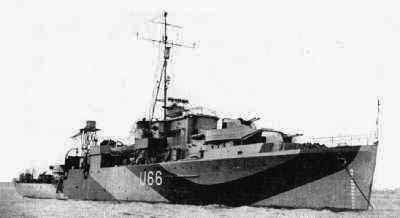 sister ships - Walkers HMS Starling and below HMS Kite 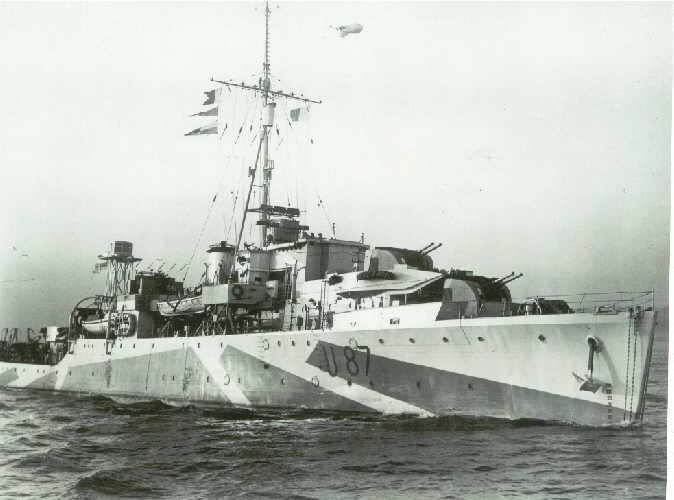 |
The following progress had been achieved
A project management team had been set up under the leadership of Captain Chris Pile RN
(retired) encompassing a wide range of relevant skills. This team reports to a steering group headed by Vice Admiral Michael Gretton CB MA FNI, currently Director of The Duke of Edinburgh’s Award.
·
·
A draft agreement was reached with the
Egyptian Ministry of Defence in November 2003, under which a two-part purchase and Alexandria based refit package was costed at £1m sterling. Conclusion of this agreement is subject to the project’s ability to raise this initial sum within a reasonable timeframe.
·
A provisional understanding has also been achieved with British Waterways for a long-term berth at the heart of Liverpool’s historic waterfront in Canning Dock, one of HMS Whimbrel’s wartime bases.
·
A preliminary scoring by the National Historic Ships Committee, the quasi-official body advising the National Lottery on grants to maritime projects has given strong hopes of top tier “core collection” status. |
But in Sept 2008, the following was announced: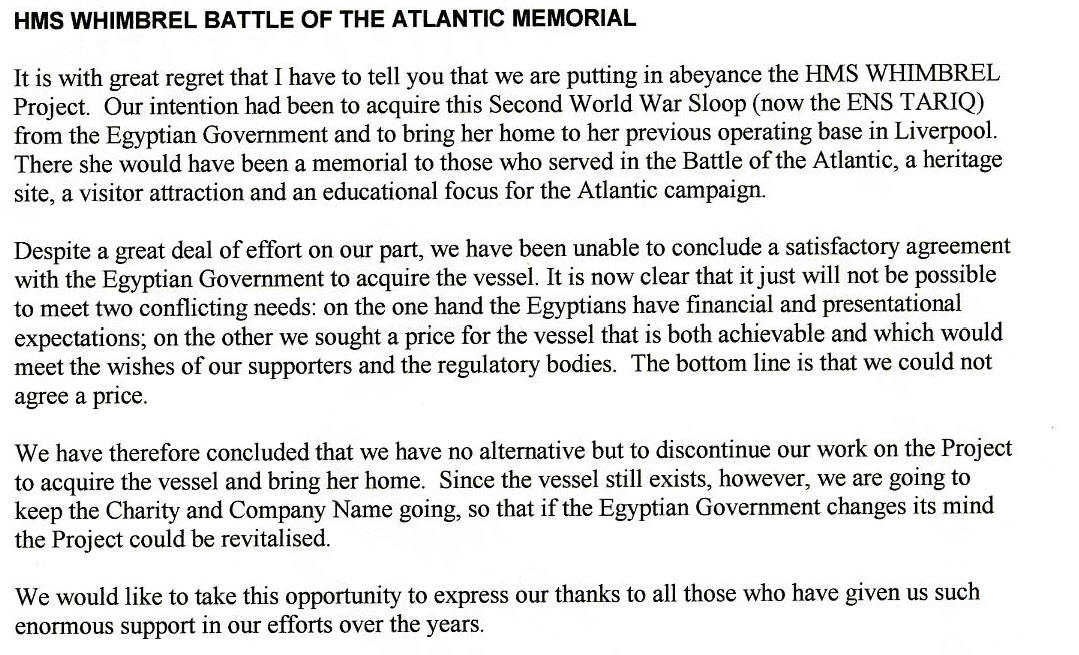 |
|
 |
 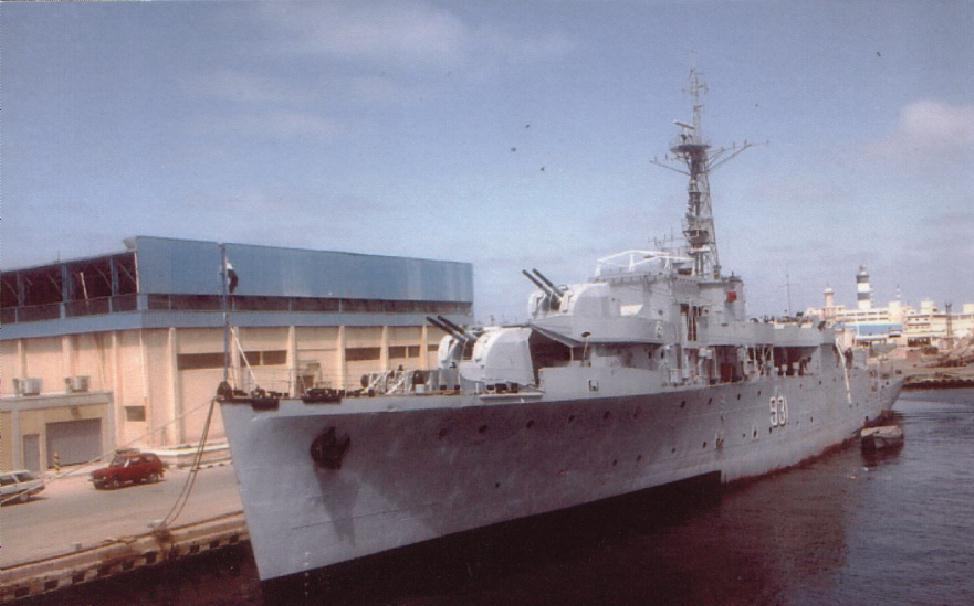 |
 |
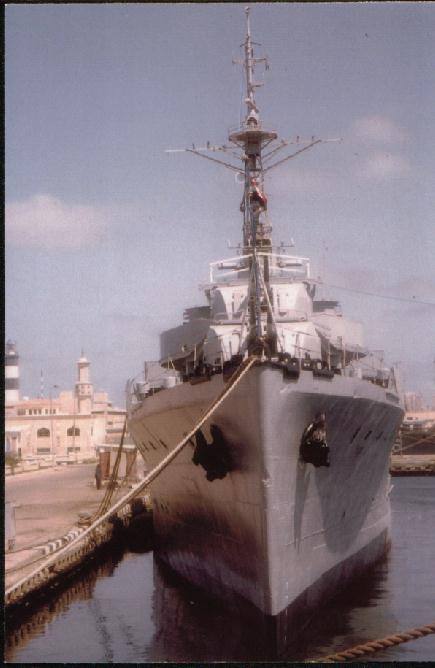 |
 |
 |
 |
 |
 |
 |
 |
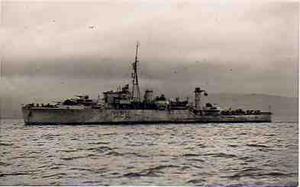 HMS Whimbrel 1943 |
|
Written back around 2003 - the relevance of which may now only be
historical Project Developments Following the Egyptian Navy’s decision to dispose of HMS Whimbrel (now ENS Tariq) in 2002 & the formation of an embryonic Battle of the Atlantic Memorial team to investigate the ship’s return to the UK, the initial focus was on obtaining access to the ship & establishing her material condition. These efforts culminated in a structural survey in February 2003, which indicated that, whilst Whimbrel was in generally sound condition, certain specific areas of corrosion would require major attention. At the time of our last update to supporters in March 2003 we anticipated that it would be relatively easy to ascertain the cost of the relevant repairs (which it was planned to undertake in Egypt) & thereby make a reasonably accurate assessment of the project’s likely economic feasibility. However, negotiations with the Egyptian authorities were far more protracted than we envisaged & it was only after much patient discussion by both sides that a draft agreement was finally reached in November 2003. This provides for the ship’s sale plus initial refurbishment in an Egyptian dockyard (including removal of all exposed asbestos) for a total sum of £1m, the agreement being subject to the project’s ability to raise this money within a reasonable timeframe. Obviously, the project’s initial members have not been idle during this time & much ongoing work has been carried out to strengthen the project team & smooth potential obstacles to the scheme’s further development. For example, detailed discussions have been held with the National Historic Ship Committee, the quasi-official body advising the National Lottery on grants to maritime projects to ascertain Whimbrel’s likely heritage ranking & this has resulted in a strong indication of potential eligibility for top tier “core collection” status once return to the UK is achieved. Achievement of this status increases the likelihood of lottery funding for the longer term conservation & conversion work planned in the UK. It should be noted that it is very difficult to obtain lottery funding for vessels currently outside of the UK, thereby presenting the project with a major financial hurdle to overcome in the first instance. Immediate Objectives With agreement on the cost of purchase & initial repair now reached, we are now in a position to investigate whether there is sufficient support to finance phases 1 to 3 of the project, which will culminate in Whimbrel’s return to a secure berth in the UK pending conversion to museum/memorial status. The project’s costings indicate that these stages can be completed within a maximum total budget of £3m, including a substantial contingency. Given the very considerable amount of funding required & the time constraints that we have to work within, we are of the opinion that any general appeal to raise funds via a large number of small donations would be unlikely to raise the money required to complete these stages. As a result, our principal fundraising efforts are being targeted on a relatively small number of major potential benefactors, with whom discussions are now commencing. Other short term objectives are focused on making a final decision on Whimbrel’s berth immediately on return to the UK & building on the substantial support that exists in Liverpool to demonstrate that the right local conditions exist to ensure the memorial’s long term sustainability. Help & Assistance Required We are pleased to receive a regular flow of offers of help with the project, both financial & non-financial. The non-financial assistance that we require tends to fluctuate depending on the project’s current focus, as new (& generally increasing levels of) help are required as we continue to make progress. We have therefore been keeping a database of the various skills that supporters have to offer, making contact with them to request specific support as the need has arisen. To give just one example, much of the recent national press publicity achieved by the project has been the result of help from a journalist who registered his support for our objectives several months previously. We would therefore ask anybody who has specific skills that might be helpful in achieving our endeavours & is happy to use these in our support to tell us about these as soon as possible – at some stage they might make a crucial contribution to the project’s success. As indicated above, it is likely that we will depend on the generosity of major benefactors for ultimate success & it is for this reason that no general appeal has been launched. At the same time, the project’s preparatory costs – not least in terms of travel to Egypt & unavoidable professional expenses – are not insubstantial, with between £5k & £10k spent to date. We are therefore extremely grateful to receive donations of any amount towards these ongoing costs. These donations allow us to finance essential work that builds our overall credibility &, thus, overall chance of success. Any cheques should be made payable to “HMS Whimbrel, Battle of the Atlantic Memorial”. Further Information Our aim is to provide additional project updates as and when there are further developments of significance and you will be kept on our mailing list unless you advise otherwise. Please feel free to contact me if you would like to receive details of any particular aspect of the project or have a specific question that you would like answering. Yours sincerely, Conrad Waters Public Relations Officer, HMS Whimbrel, Battle of the Atlantic Memorial |
I reproduce these emails here in the event that the information may well help someone else in their quest for information: I received an email from Mike Sewell, Hornsea East Yorkshire 26 November 2004. Reprinted here: HMS Whimbrel was adopted by the small Yorkshire seaside resort of Hornsea in the Autumn of 1942. The town's original choice had been the Flower Class corvette, HMS Arbutus. The reason for this was that the son of the chairman of Hornsea's National Savings Committee was an officer in Arbutus. Tragically, Arbutus was torpedoed and sunk on 5th February 1942, just two days before the start of Hornsea's fund raising Warship Week. I do not know why Whimbrel was chosen in the place of Arbutus, or whether there were any Hornsea men who served in the ship. The local press has just two references to Whimbrel up to the end of the War. First, in April 1944, the Hornsea Urban District Council announced a scheme for local people to donate 100 books and money for a bookcase, to be sent to Whimbrel. In January 1945 the Council received a letter from an officer in HMS Whimbrel which stated that the crew were anxious for pen friends and would like the names and addresses of Hornsea girls who were willing to write, as well as those of Hornsea girls who were serving in the WRNS, ATS or WAAF. The Council agreed to compile a list. Hornsea still has a Whimbrel Avenue, which is on a council estate which was built shortly after the War. From Conrad in reply to a request for help from Beverley: 13 Feb 05: Mike Kemble has been kind enough to pass on your request regarding Captain Murch of the former HMS Whimbrel to me in my role of public relations officer for the project attempting to preserve this ship as a Memorial to the Battle of the Atlantic. I hope that I will be able to provide you with a few leads. Lt Commander N(orman) R Murch was, as I understand it, Whimbrel's third and final RN commanding officer, having assumed command to take her out to the Pacific in 1945. As such, he was with her in Tokyo Bay to witness the formal Japanese surrender in September 1945. Prior to that, he had been in command of the destroyer HMS Beagle, during which time he gained a reputation as something of a war hero for the successful rescue of the crews of the American landing craft LST314 and LST376 from the middle of a minefield shortly after the D Day landings. There are a few passages about this incident in the recent book "Destroyer" (Editor: Ian Hawkins, published Conway Maritime Press 2003). So far as crew lists and contacts are concerned, your best point of reference is probably George Fancett, Secretary of the HMS Whimbrel Association and I have taken the liberty of copying this E-mail to him. George was a boy seaman on Whimbrel during this third commission and has been very helpful in supporting our efforts to preserve his ship. I also have been in correspondence with the Rev R Much (Norman Murch's nephew, from recollection) and I have sent him a blind copy of this E-mail in case he would like to make direct contact.
|
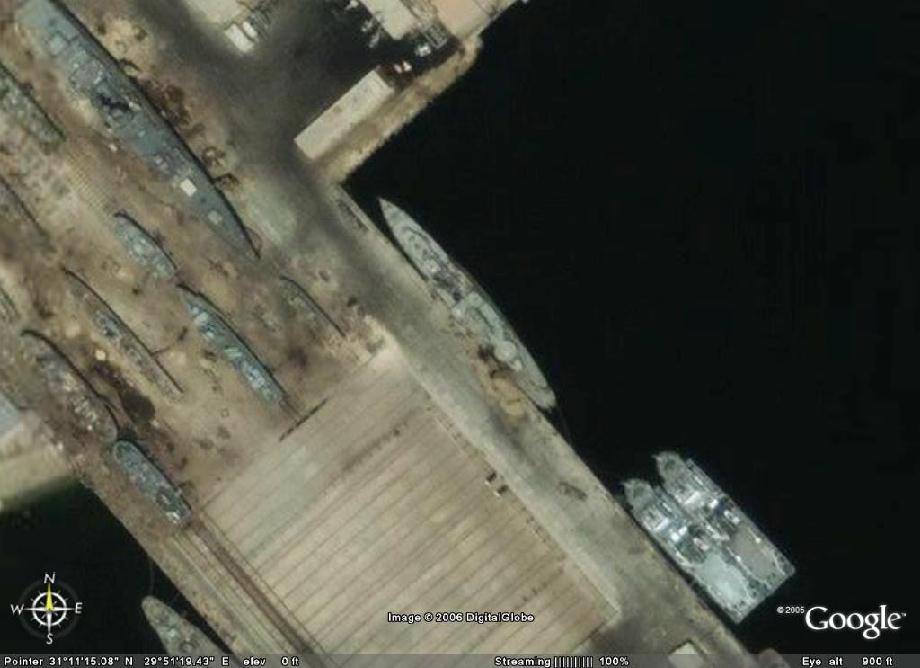 |
 |
|
January 2006: Martin Carr, who resurrects old faded images for me, found
the Whimbrel (Currently Tariq) via the satellite program Google Earth. Here she
is with salient features highlighted by Martin to compare her with the schematic
of HMS Starling.
http://earth.google.com
|
From Ron Pudduck: April 2010: Formerly I was a member of the Project Team led by Vice Admiral Mike Gretton in the role of naval architect, providing technical advice and maintaining archive material required for the conservation and restoration of ex-HMS Whimbrel. I carried out the survey of the ship at Alexandria in August 2005 and developed the documentation to support Heritage Lottery Funding (ie Conservation Management Plan, Audience Development Plan, Access Plan etc). A refit Specification was also produced in readiness for engaging with contractors to undertake the work firstly in Egypt to prepare the ship for lifting onto a ship transport vessel for the journey to the UK and subsequently for conservation/restoration in Liverpool. Sadly as it has been explained elsewhere and despite strenuous and repeated efforts by the Project Team and many others, it was not possible to get agreement with the Egyptian government on the terms for the sale of the ship. In the course of my efforts to gather technical information I was fortunate to meet a large number of enthusiastic ex-MoD engineers with long memories and ex-RN crew members who had served in or knew Whimbrel or others of the class. With their help I have amassed considerable details that so far as I know are not recorded elsewhere, that will be invaluable to a) understand and therefore help the restoration and b) provide an insight to life onboard with many stories and personal experiences to add colour to the outline history that is all that is recorded in museums, reference books and archives. It was the personal content collected by interviews and conversations captured on a voice recorder that spurred me to write a book of the ship’s history – which is now well advanced. Encouraged by the great naval historian David Brown (who sadly died last year) once my boss in the MoD, I intend to produce a record that hopefully will be more than a technical read, that would only appeal to a few naval enthusiasts. If we cant bring the ship home in the near future, in the meantime at least the book will be a lasting testament and reminder of the debt we all owe to the largely forgotten brave souls who clung to iron ladders in the suffocating heat of the boiler rooms, were numbed and blinded by driving rain and sleet on the open bridge, guns and look-out positions or suffered the misery of upset food and soaked bedding in the mess decks, as the little ships corkscrewed and slammed in freezing Atlantic or Arctic storms. The record of the improved Black Swans as perhaps the best anti-submarine escort vessels of WW2 when organised and led by luminaries such as Johnnie Walker is well known. Less well known perhaps is the role of these ships in the Pacific and the pace and influence of improvements and innovations in weapons and equipment during the latter war years. Still less has been written with first hand input, of the humour, boredom and banalities that formed the counterpoint to the hard work, routines and fears that were part of 24 hour life in the wardroom as well as on the lower deck in the dark days of WW2... I am still collecting material and welcome any offerings particularly from ex-crew of escort vessels of all types. Pride of place will of course be given to any ex-Whimbrels, crew of her sisters and handed-down tales from their families and friends. As said before, any offered material, photographs, note books etc will be carefully handled, accredited in the book and safely returned. |
|
|
|
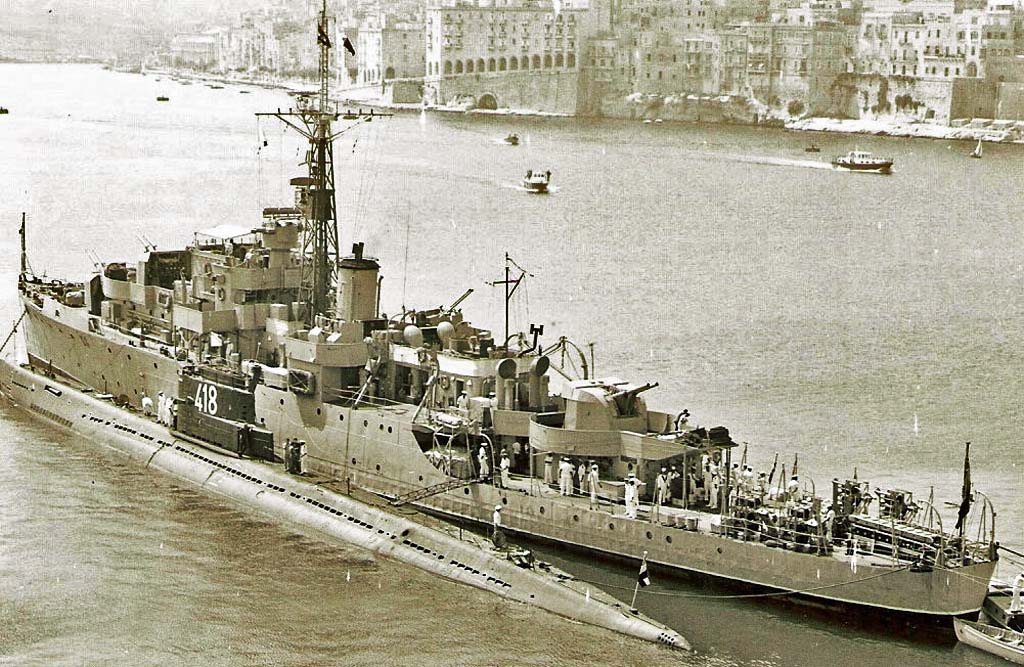 |
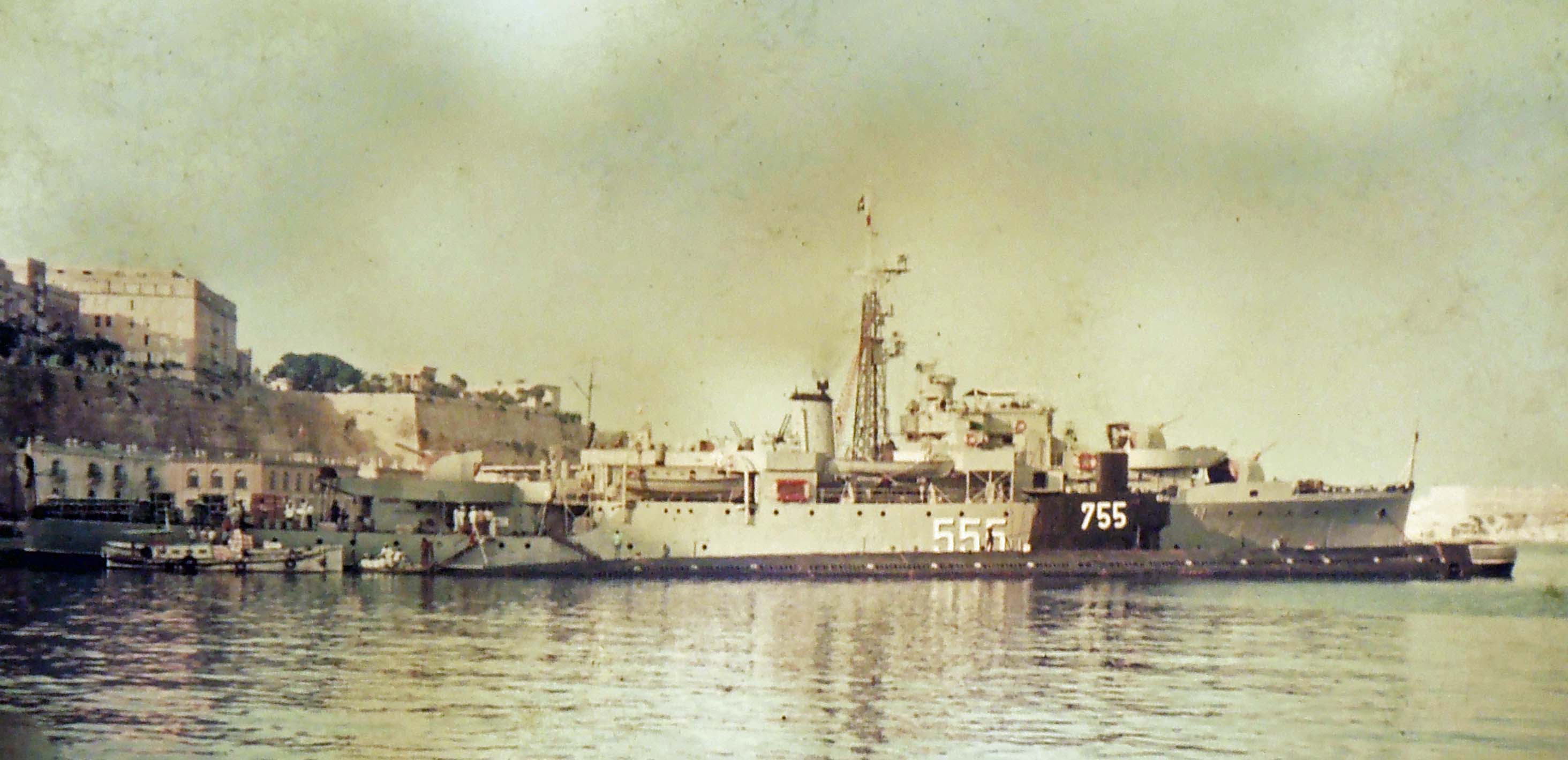 |
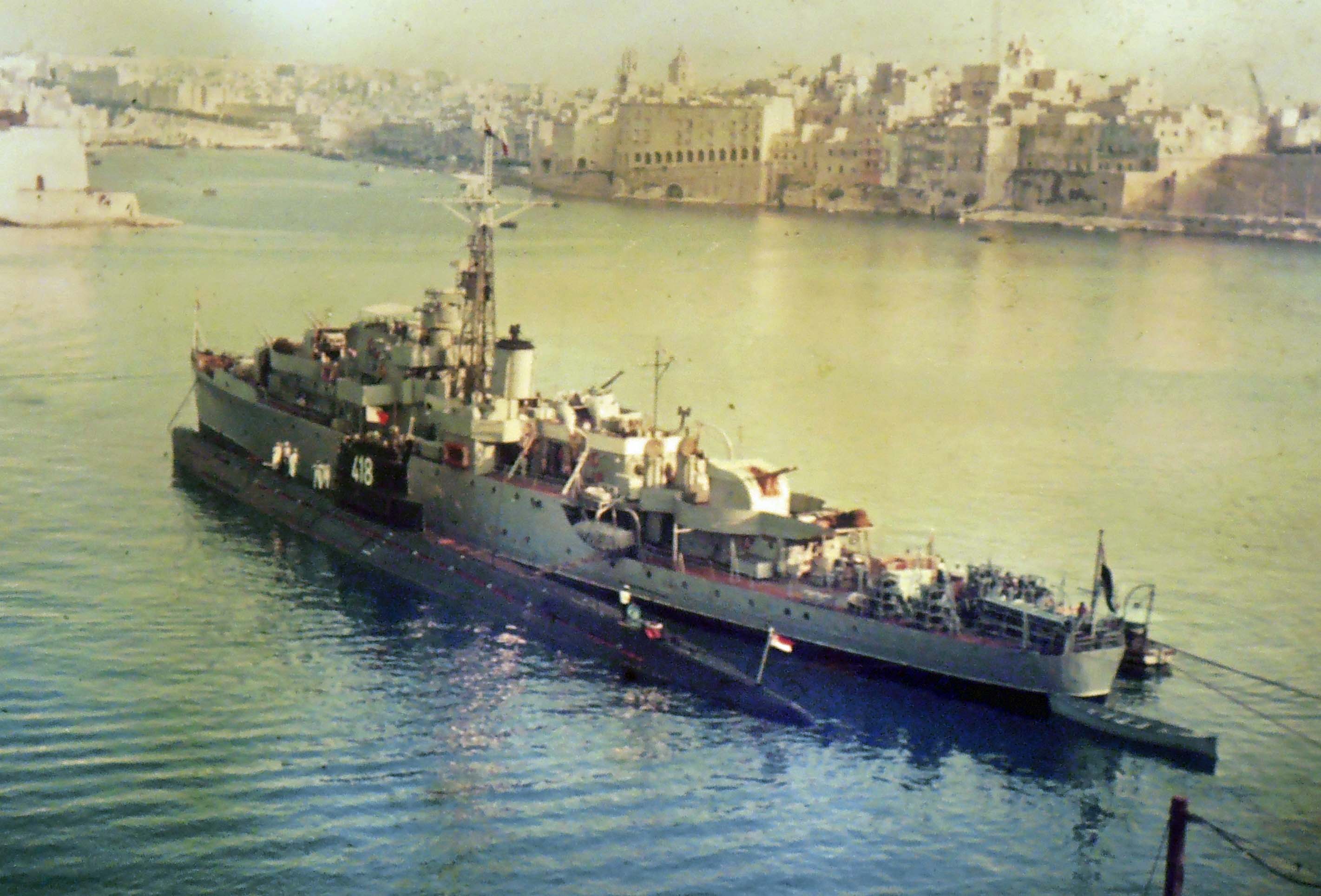 |
These three images of the
(Whimbrel) Tariq (Tarek) were found on a forum about the Egyptian Armed
Forces and show the ENS Tariq in Valetta Harbour Malta. They were posted
by a man known as Fremo on the forum but there is no contact means
unless I join the forum. The sub in view (left) is a Romeo class former
Soviet submarine. Thanks to Rod Puddock for that snippet. http://far-maroc.forumpro.fr/t184p945-armee-egyptienne-egyptian-armed-forces |
|
The ship will remind us of their bravery ; The Daily Post's campaign to save Captain Johnnie Walker's last ship is backed by his daughter Gillian. Here she tells Peter Elson about her distinguished father Daily Post (Liverpool); Oct 24, 2002; p. 9 THE cold, great granite blocks of Gladstone Dock lie tight and mute, encasing leaden, still waters. These silent stones have witnessed countless comings and goings over the years, but none that compared with the exploits of Captain "Johnnie" Walker. These dock walls once echoed to his ship HMS Starling's signature tune "A Hunting We Will Go" - a clarion cry to battle as his flotilla forged out into the Mersey on yet another U-boat mission during the Battle of the Atlantic. Capt Walker received the DSO and three bars for his group sinking more U-boats than any other, destroying 20 submarines in total. Capt Walker's daughter, Gillian Walker, is giving her full support to the Daily Post campaign to save HMS Whimbrel. This is the sole surviving vessel from Capt Walker's escort group, now laid up at Alexandria by her present owners, the Egyptian Navy. Miss Walker says: "I think it's a wonderful idea to get the Whimbrel back. She's not only the last ship of my father's group, but also the last Battle of the Atlantic warship, so it would be awful if she was lost. "The Egyptian attitude is all in our favour, so this is worth trying. It's a very good idea especially to moor her in the Canning Dock, which I remember very well. It's strange that a U-boat can be preserved in Birkenhead while it takes such an effort get Whimbrel back home to Liverpool." Miss Walker was last in Liverpool almost exactly four years ago when a statue of her father was unveiled at the Pier Head by the Duke of Edinburgh. Prince Philip commanded HMS Magpie, a Black Swan sister ship to Whimbrel and Walker's two commands Starling and Stork. Miss Walker vividly remembers those days, nearly six decades ago at Gladstone Dock, when her father was arguably the most famous man in Liverpool. After nearly a month at sea, Capt Walker returned to Gladstone Dock on February 24, 1944, to an ecstatic welcome, having sunk six U-boats in one of the most brilliant operations ever recorded in the Royal Navy's long history. "It was a marvellous occasion with the ships arriving in line after they had sunk six U-boats and everybody had gathered on the dock, including me," says Miss Walker, now in her late 70s. "They had a line of signal flags across the dock saying 'Johnnie Walker still going strong!'. Johnny Walker's Whisky company sent my father a case of whisky to celebrate. "My father wasn't really a drinker, but his main party trick in the ward room was standing on his head and drinking a glass of beer. My mother wasn't shocked, she thought it was great. I could do it too - we Wrens wore bell bottoms you see. "My father was a modest man, but I remember him getting annoyed when he failed his driving test. He came back and said, 'If I can drive a bloody battleship then I should be able to drive a flipping car!' "He was super fun to have around. He loved swimming, playing tennis and going fishing. He had plenty of energy and a jolly good sense of humour. The best place we had was in Weymouth before the war. It was the first time we were all together as a family, but it only lasted a year or two." Johnnie Walker was not only a superb tactician, but had an incredible presence that gained the affection and respect of his crews. He welded his group into a highly-efficient fighting force that deployed new methods of anti-submarine warfare.'He was an optimist. He knew his job and how to get the most out of people. In a way, he loved his men as much as he loved them. My father did as much for them as he could at sea'. "That's why I suppose Capt Walker's Old Boys Association was formed as they wanted to remember him," says Miss Walker, whose mementoes include the patchwork leather jacket her father wore on Starling's bridge. "My father's success was widely known and the Liverpool papers were full of his exploits because it was a bit of good news and the rest of the war news were so bad. I felt very proud of him, but being very young at the time took it for granted. He just did the job he was instructed to do. With Capt Walker leading the U-boat campaign, the strain on his wife, Eileen, was enormous. Miss Walker says: "She was a very strong woman who had a had a lot of illness in her life, but was absolutely devoted to my father and we were a very happy family. The Walkers lived at Grassendale Park, literally a few yards from the Mersey. Previously, the family were in Dover, while Capt Walker worked on Admiral Ramsay's staff during Dunkirk. "He nagged at the Admiralty to give him a ship, as he was trained as an antisubmarine bloke. He eventually got appointed to HMS Stork which pleased him very much," says Miss Walker. 'We moved up to Liverpool, although I was away at school then and only allowed home once because of the air raids. I joined up as a Wren in 1943 when I was 18 years old, but my younger brother, Andrew, was only born in 1939 and my elder brother, Timmy, had been out in Rome for three years training to be a priest." Tim was lost in the Mediterranean while serving aboard the submarine HMS Parthian, a few weeks before Capt Walker died himself from over exhaustion. He collapsed at a Liverpool cinema and died shortly afterwards. Miss Walker says: "My mother was very strong and brave over it and at the time he died she said how awful it was for me 'losing your father at such a young age'. I said, 'It's worse for you.' It left a dreadful gap in my mother's life. She never remarried and would never have considered it. "My father's death was a terrible shock as he'd always been a very healthy bloke and never had anything wrong with him. He was just tired out every time he came home. He was on ship's bridge day and night, suffering acute lack of sleep. It wasn't just the U- boats, but also the horrific North Atlantic winter storms." When Capt Walker died he was accorded a near state funeral through the streets to Liverpool Cathedral. Miss Walker says: "My mother and I didn't join the procession down to the dock, we just boarded HMS Hesperus there. I think my brother Nick marched behind the coffin through Liverpool. Capt Walker was buried at sea in Liverpool Bay. "It was a deeply moving. It's the only occasion I can never remember saluting my father. It was a very solemn occasion, with everyone gathered on the quarter deck as the coffin went overboard. My mother threw a wreath. It was a very dull, misty day. The sort of day they'd encounter when they went out 'on the hunt'. It's all a long time ago and I wouldn't expect the next generation to know, which is why saving Whimbrel will help. "My father never thought he was doing anything special. He would be utterly surprised by the whole fuss, he'd laugh his head off at the idea of one of the Virgin Trains named after him. |
|
| It is of vital importance to our maritime history that this ship be returned home to Liverpool, to the home of Capt Walker RN. | |
| In
Wikipedia: In November 1949 she was sold to Egypt and renamed El Malek
Farouq. In 1954 she was renamed Tariq. A preservation attempt launched in 2006 aimed to bring her to Canning Dock Liverpool as a memorial to those who died on the Atlantic Convoys. On 26 March 2008 a plaque celebrating the ship was presented to the Mayor of Sefton. John Livingston, president of the Liverpool branch of the Whimbrel Project, said: "She’d be a marvellous addition to our waterfront and a reminder of the sacrifice of our seamen". The Mayor of Sefton, Cllr Richard Hands, said: "HMS Whimbrel forms a unique part of both our social and maritime history and I fully support the campaign to bring her back to Liverpool".The attempt stalled when it was not possible to agree a price with the Egyptian Government. Then, in 2016, it was reported in Parliament that the Egyptian Navy had offered her for sale to the National Museum of the Royal Navy, Portsmouth for £725,000, and that the museum had shown an interest in housing HMS Whimbrel and is investigating the possibility of bringing it back to the UK. This was 2016 and I have heard nothing since. |
|